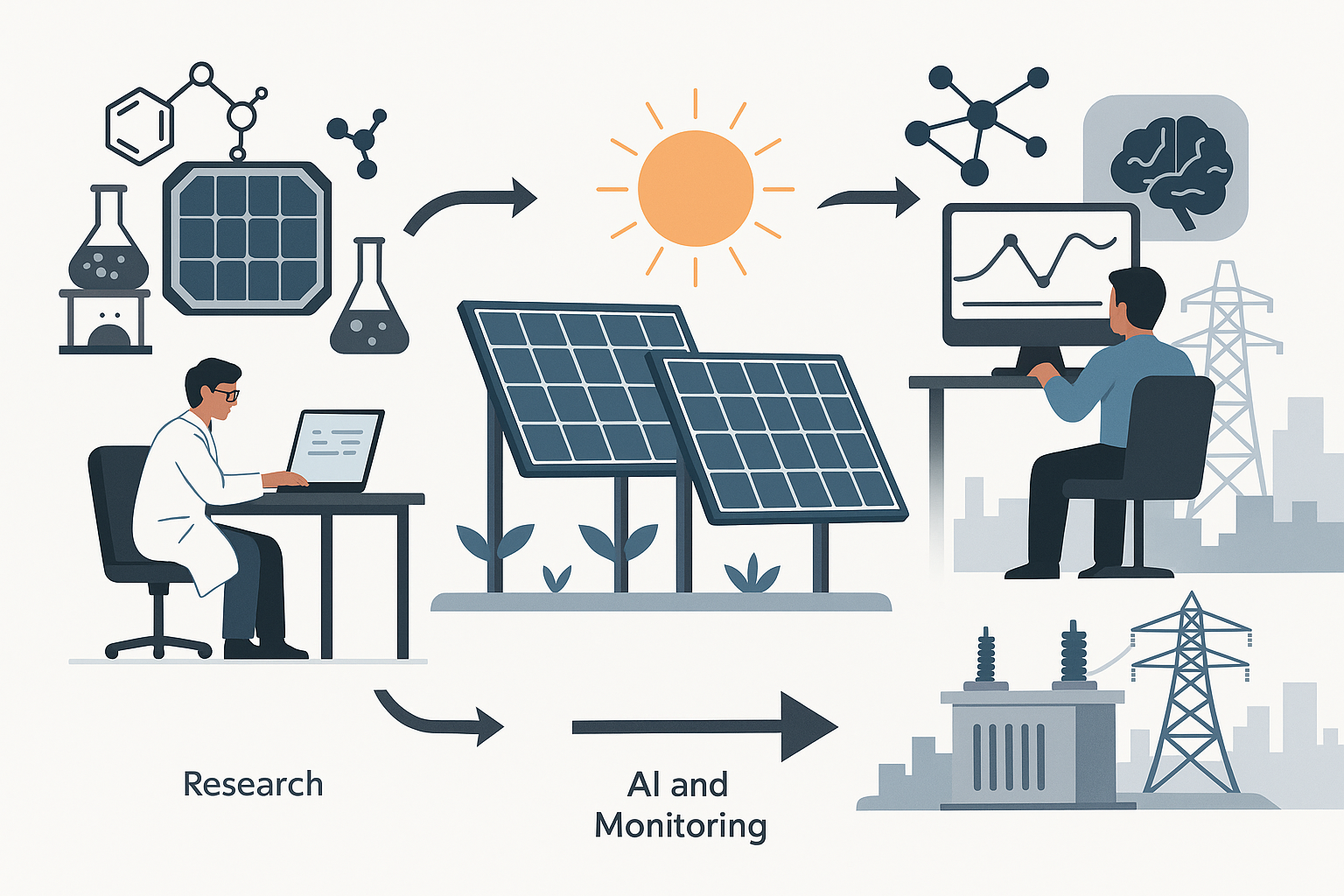
Solar photovoltaic (PV) technology has become one of the cornerstones of the global clean energy transition. Yet, behind every panel on a rooftop or utility-scale solar farm lies years of research and innovation. The pathway from academic breakthroughs to large-scale deployment is often overlooked, but it plays a critical role in shaping the reliability, efficiency, and affordability of renewable energy.
Researchers like Fozlur Rayhan, founder of GridNova Technologies, are working at the intersection of solar cell innovation and real-world energy applications. His research on perovskite and CZTSSe thin-film solar cells demonstrates how laboratory discoveries can directly influence commercial energy systems. The key is building a bridge between theory and practice — a journey from lab to grid.
The Promise of Next-Generation Solar Materials
Conventional silicon-based solar panels dominate the market today. While proven and reliable, they face limitations in efficiency gains, cost reductions, and material sustainability. This has pushed researchers to explore next-generation materials like perovskites and kesterite compounds such as CZTSSe (Copper-Zinc-Tin-Sulfur-Selenium).
- Perovskite solar cells are lightweight, flexible, and capable of reaching high efficiencies under laboratory conditions. They also allow tunable bandgaps, making them suitable for tandem cells that can surpass the theoretical efficiency limits of silicon.
- CZTSSe solar cells, on the other hand, are made of earth-abundant, non-toxic materials, offering a more sustainable alternative to conventional PV technologies.
Rayhan’s work has focused on numerical modeling and buffer layer optimization for these materials. By simulating electron transport layers (ETLs), absorption profiles, and interface dynamics, he and his peers have demonstrated meaningful improvements in solar conversion efficiency. These findings are not confined to academic journals — they lay the foundation for cost-effective, commercially viable PV modules.
Bridging the Research-to-Deployment Gap
One of the challenges in solar innovation is translating laboratory prototypes into scalable, durable systems that can withstand years of operation in harsh outdoor conditions. This is where ventures like GridNova Technologies step in, connecting research insights with real-world engineering solutions.
Key strategies for bridging this gap include:
- Material-to-System Integration
Discoveries in perovskite or CZTSSe optimization must align with inverter technology, hybrid storage, and grid codes. GridNova’s focus on AI-powered inverter optimization ensures that efficiency gains in cells are not lost at the system level. - Predictive Diagnostics for Emerging PV
Advanced materials are often more sensitive to defects and degradation. By embedding AI fault detection algorithms into PV monitoring systems, companies can extend the operational life of next-generation solar cells in field deployments. - Pilot Projects for Validation
Moving from lab prototypes to pilot-scale modules deployed in microgrids or small solar farms allows researchers to validate performance in real-world conditions — temperature fluctuations, humidity, dust, and grid variability. - Policy and Industry Alignment
U.S. federal initiatives such as the DOE Solar Futures Study and Energy Storage Grand Challenge emphasize the importance of durable, efficient solar technologies. Academic breakthroughs aligned with these priorities have a faster path to commercialization and adoption.
The Role of AI in Scaling PV Innovation
AI and machine learning are proving indispensable in accelerating the “lab-to-grid” journey. Rayhan’s research integrates AI-driven diagnostics and optimization alongside solar cell innovation. For example:
- Optimization of Experimental Parameters: AI can analyze massive datasets of material compositions and fabrication techniques to identify the most promising pathways for efficiency improvements.
- Predictive Maintenance: Once deployed, AI-powered fault detection ensures solar panels deliver peak performance, reducing downtime and repair costs.
- Hybrid System Modeling: Combining next-gen solar cells with batteries or supercapacitors requires complex simulations that AI tools can streamline, making systems more adaptable to rural and urban deployments alike.
Real-World Applications: From Communities to National Impact
The benefits of translating solar research into real-world impact extend beyond scientific achievement — they address pressing energy and social needs.
- Rural Electrification: Affordable, durable thin-film modules combined with AI monitoring make solar viable for underserved communities, reducing reliance on diesel generators.
- Urban Grid Resilience: Next-generation PV integrated with smart inverters enhances grid stability, particularly during peak demand.
- Economic Growth: New solar technologies fuel domestic manufacturing, workforce training, and job creation — key objectives under the DOE Grid Modernization Strategy.
By 2028, GridNova’s roadmap envisions deploying AI-driven solar optimization systems across the U.S., supporting 25+ utilities and renewable developers while creating 15–20 high-skilled jobs in power engineering, AI, and cybersecurity. The direct translation of research into business outcomes ensures that innovations in perovskite and CZTSSe do not remain confined to laboratories but instead reshape the nation’s clean energy infrastructure.
Conclusion
The future of solar energy is not just about discovering new materials — it’s about ensuring those discoveries translate into reliable, scalable, and impactful technologies. From Rayhan’s research on perovskite and CZTSSe optimization to GridNova’s applied AI diagnostics and inverter innovations, the journey from lab to grid demonstrates how science and entrepreneurship can accelerate the clean energy transition.
By embracing this bridge, we can transform groundbreaking academic research into everyday solutions — delivering cleaner power to homes, stabilizing the grid, and building a sustainable energy future.
